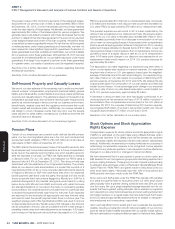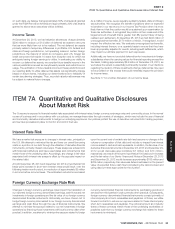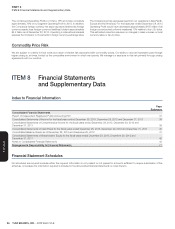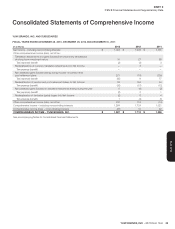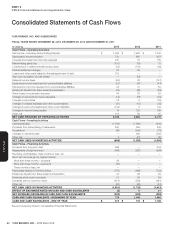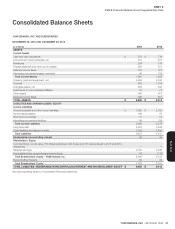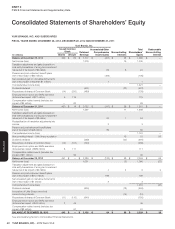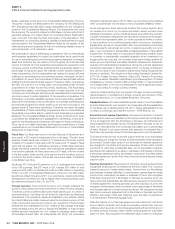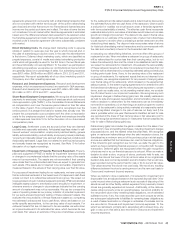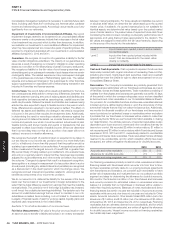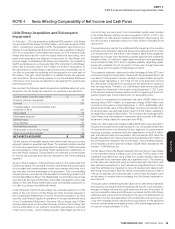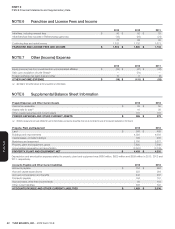Pizza Hut 2013 Annual Report Download - page 140
Download and view the complete annual report
Please find page 140 of the 2013 Pizza Hut annual report below. You can navigate through the pages in the report by either clicking on the pages listed below, or by using the keyword search tool below to find specific information within the annual report.
YUM! BRANDS, INC.-2013 Form10-K44
Form 10-K
PART II
ITEM 8Financial Statements andSupplementaryData
Sheep, separately on the face of our Consolidated Statements of Income.
The portion of equity not attributable to the Company for KFC Beijing and
KFC Shanghai is reported within equity, separately from the Company’s
equity on the Consolidated Balance Sheets. The shareholder that owns
the remaining 7% ownership interest in Little Sheep holds an option that, if
exercised, requires us to redeem their non-controlling interest. Redemption
may occur any time after the third anniversary of the acquisition. This
Redeemable non-controlling interest is classified outside permanent equity
and recorded in the Consolidated Balance Sheet as the greater of the
initial carrying amount adjusted for the non-controlling interest’s share of
net income (loss), or its redemption value.
We participate in various advertising cooperatives with our franchisees
and licensees established to collect and administer funds contributed
for use in advertising and promotional programs designed to increase
sales and enhance the reputation of the Company and its franchise
owners. Contributions to the advertising cooperatives are required for both
Company-owned and franchise restaurants and are generally based on a
percentage of restaurant sales. We maintain certain variable interests in
these cooperatives. As the cooperatives are required to spend all funds
collected on advertising and promotional programs, total equity at risk is
not sufficient to permit the cooperatives to finance their activities without
additional subordinated financial support. Therefore, these cooperatives
are VIEs. As a result of our voting rights, we consolidate certain of these
cooperatives for which we are the primary beneficiary. The Advertising
cooperatives assets, consisting primarily of cash received from the
Company and franchisees and accounts receivable from franchisees,
can only be used to settle obligations of the respective cooperative. The
Advertising cooperative liabilities represent the corresponding obligation
arising from the receipt of the contributions to purchase advertising and
promotional programs for which creditors do not have recourse to the
general credit of the primary beneficiary. Therefore, we report all assets
and liabilities of these advertising cooperatives that we consolidate as
Advertising cooperative assets, restricted and Advertising cooperative
liabilities in the Consolidated Balance Sheet. As the contributions to these
cooperatives are designated and segregated for advertising, we act as an
agent for the franchisees and licensees with regard to these contributions.
Thus, we do not reflect franchisee and licensee contributions to these
cooperatives in our Consolidated Statements of Income or Consolidated
Statements of Cash Flows�
Fiscal Year. Our fiscal year ends on the last Saturday in December and,
as a result, a 53
rd
week is added every five or six years. The first three
quarters of each fiscal year consist of 12 weeks and the fourth quarter
consists of 16 weeks in fiscal years with 52 weeks and 17 weeks in fiscal
years with 53 weeks. Our subsidiaries operate on similar fiscal calendars
except that China, India and certain other international subsidiaries operate
on a monthly calendar, and thus never have a 53
rd
week, with two months
in the first quarter, three months in the second and third quarters and four
months in the fourth quarter. YRI closes one period earlier to facilitate
consolidated reporting.
Fiscal year 2011 included 53 weeks for our U.S. businesses and a portion
of our YRI business. The 53rd week in 2011 added $91 million to total
revenues, $15 million to Restaurant profit and $25 million to Operating
Profit in our 2011 Consolidated Statement of Income. The $25 million
benefit was offset throughout 2011 by investments, including franchise
development incentives, as well as higher-than-normal spending, such
as restaurant closures in the U.S. and YRI.
Foreign Currency. The functional currency of our foreign entities is the
currency of the primary economic environment in which the entity operates.
Functional currency determinations are made based upon a number of
economic factors, including but not limited to cash flows and financing
transactions. The operations, assets and liabilities of our entities outside
the United States are initially measured using the functional currency of that
entity. Income and expense accounts for our operations of these foreign
entities are then translated into U.S. dollars at the average exchange
rates prevailing during the period. Assets and liabilities of these foreign
entities are then translated into U.S. dollars at exchange rates in effect
at the balance sheet date. As of December 28, 2013, net cumulative
translation adjustment gains of $170 million are recorded in Accumulated
other comprehensive income (loss) in the Consolidated Balance Sheet.
As we manage and share resources at either the country level for all of
our brands in a country or, for some countries in which we have more
significant operations, at the individual brand level within the country,
cumulative translation adjustments are recorded and tracked at the foreign-
entity level that represents either our entire operations within a country
or the operations of our individual brands within that country. Translation
adjustments recorded in Accumulated other comprehensive income (loss)
are subsequently recognized as income or expense generally only upon
sale or upon complete or substantially complete liquidation of the related
investment in a foreign entity. For purposes of determining whether a sale
or complete or substantially complete liquidation of an investment in a
foreign entity has occurred, we consider those same foreign entities for
which we record and track cumulative translation adjustments. Restaurant
closures and refranchising transactions during the periods presented
constituted disposals or sales of assets within our foreign entities and
thus did not result in any translation adjustments being recognized as
income or expense. The adoption of Accounting Standards Update No.
2013-05, Foreign Currency Matters, (Topic 830): Parent’s Accounting
for the Cumulative Translation Adjustment upon Derecognition of Certain
Subsidiaries or Groups of Assets within a Foreign Entity or of an Investment
in a Foreign Entity, in 2014 is not anticipated to have a significant impact
on our accounting for foreign currency matters.
Gains and losses arising from the impact of foreign currency exchange
rate fluctuations on transactions in foreign currency are included in Other
(income) expense in our Consolidated Statement of Income.
Reclassifications. We have reclassified certain items in the Consolidated
Financial Statements for prior periods to be comparable with the classification
for the fiscal year ended December 28, 2013. These reclassifications had
no effect on previously reported Net Income – YUM! Brands, Inc.
Franchise and License Operations. We execute franchise or license
agreements for each unit operated by third parties which set out the terms
of our arrangement with the franchisee or licensee. Our franchise and
license agreements typically require the franchisee or licensee to pay an
initial, non-refundable fee and continuing fees based upon a percentage
of sales. Subject to our approval and their payment of a renewal fee, a
franchisee may generally renew the franchise agreement upon its expiration.
The internal costs we incur to provide support services to our franchisees
and licensees are charged to General and Administrative (“G&A”) expenses
as incurred. Certain direct costs of our franchise and license operations
are charged to franchise and license expenses. These costs include
provisions for estimated uncollectible fees, rent or depreciation expense
associated with restaurants we lease or sublease to franchisees, franchise
and license marketing funding, amortization expense for franchise-related
intangible assets and certain other direct incremental franchise and license
support costs.
Revenue Recognition. Revenues from Company-owned restaurants are
recognized when payment is tendered at the time of sale. The Company
presents sales net of sales-related taxes. Income from our franchisees
and licensees includes initial fees, continuing fees, renewal fees and rental
income from restaurants we lease or sublease to them. We recognize
initial fees received from a franchisee or licensee as revenue when we
have performed substantially all initial services required by the franchise
or license agreement, which is generally upon the opening of a store. We
recognize continuing fees, which are based upon a percentage of franchisee
and licensee sales and rental income as earned. We recognize renewal
fees when a renewal agreement with a franchisee or licensee becomes
effective. We present initial fees collected upon the sale of a restaurant
to a franchisee in Refranchising (gain) loss.
While the majority of our franchise agreements are entered into with terms
and conditions consistent with those at a prevailing market rate, there are
instances when we enter into franchise agreements with terms that are not
at market rates (for example, below-market continuing fees) for a specified
period of time. We recognize the estimated value of terms in franchise


